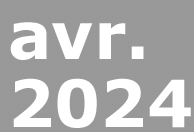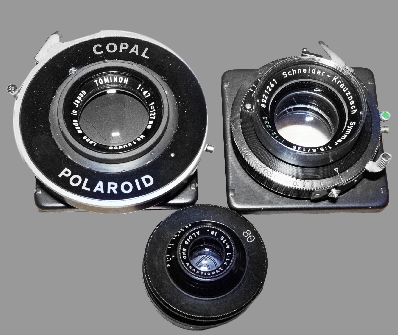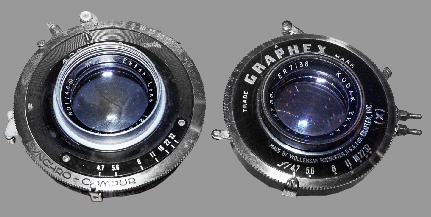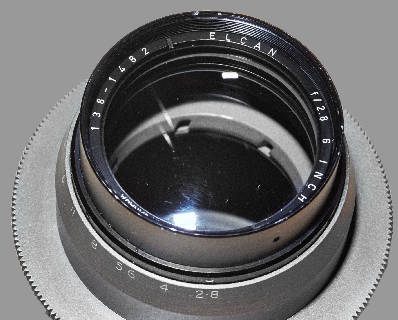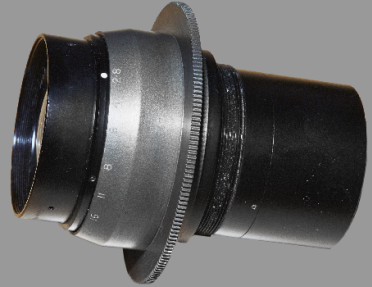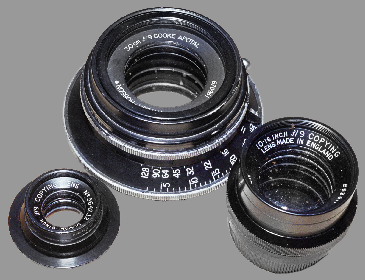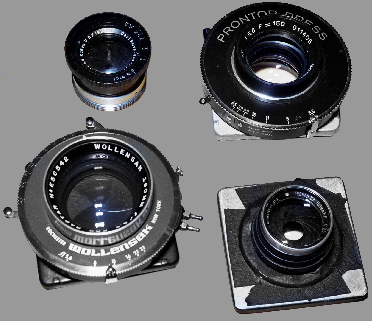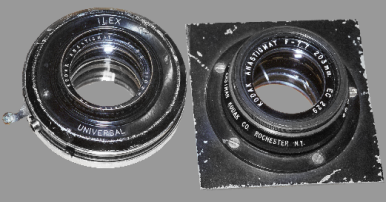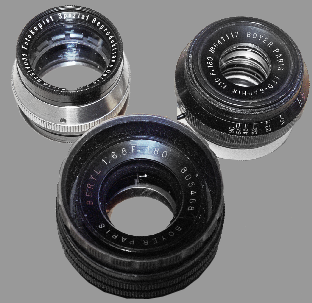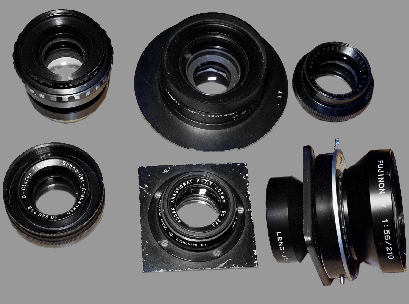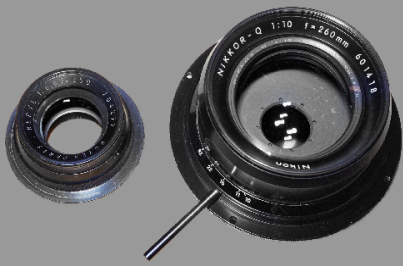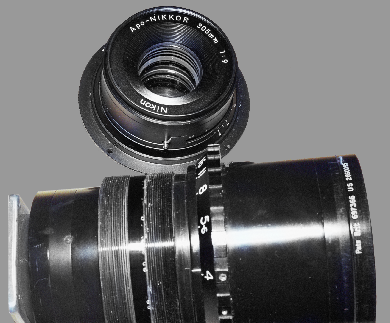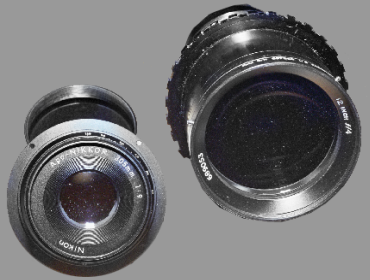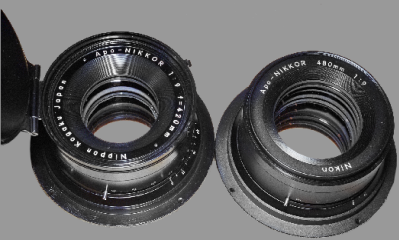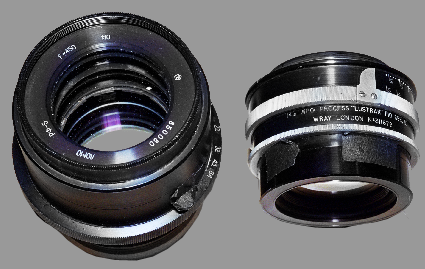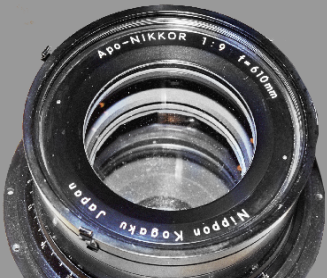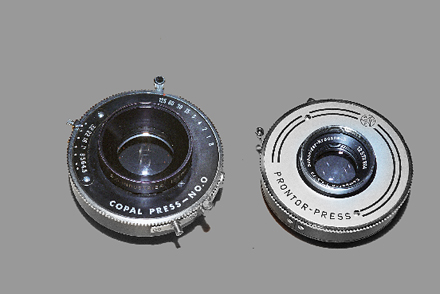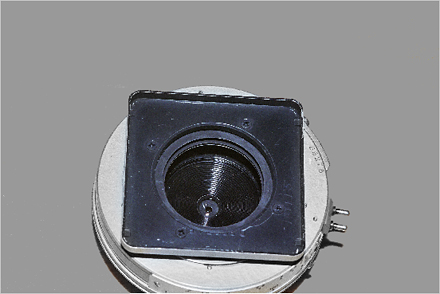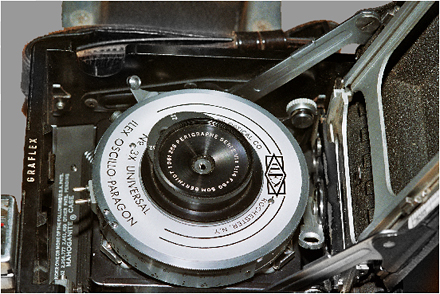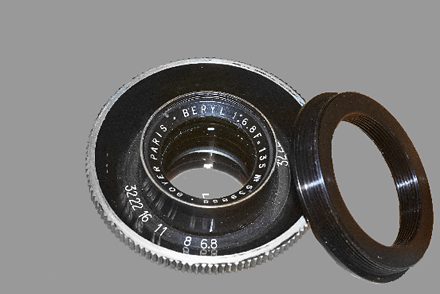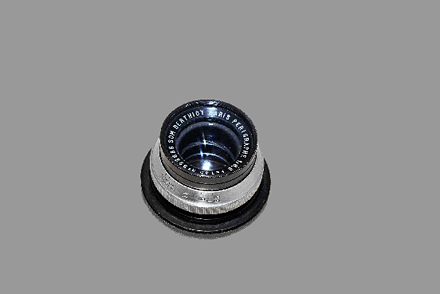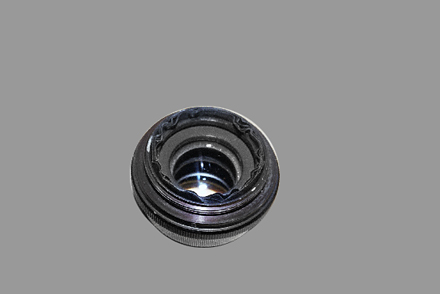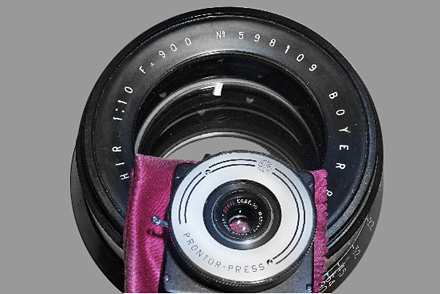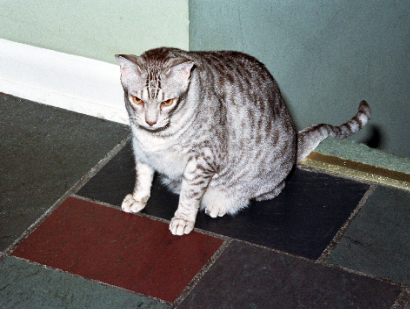|
|
|||||||||||||||||||||||||||
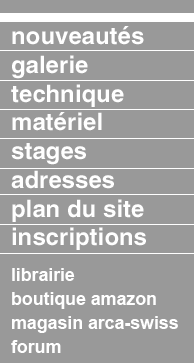
the authors
Adaptation
|
Unlikely lenses on 2¼ x 3¼ GraphicsPart 3: Lenses useful out-and-about at normal distances by Daniel W. Fromm Dedicated to the memory of Charlie Barringer (1943-2010) Contents6 Lenses useful out-and-about at normal distances6.2 Description of lenses6.2.3 5” to 7” (127 mm to 180 mm)5”/4 Ross Wide Angle Xpres [sold]. Uncoated, stops only to f/11. According to the Vade Mecum, this is a “very high quality lens” and “the f4/5in lens for the MoD is apparently an f3.1 lens, as the front glass is some 28% oversize and actually bigger than a normal 6in. It covers an enormous field really well, most of 1/1 plate in fact [4].” Its glasses are fairly clean but there are some marks on the rear element that won’t come off. Of interest, the rear cell is easily unscrewed but the front cell is prevented from unscrewing by a lock screw that’s easy to remove, hard to replace. The flange is integral with the barrel so mounting it will be problematic. The Vade Mecum warns of separations but mine has none. It seems to be, as the Vade Mecum says, a six element wide angle Plasmat [3]. Bought in a store. Test shots with it on 35 mm film were not very sharp at any aperture and were quite flary. For me, unusable, but not a bad $10 gamble. 5”/4.5 Cooke Aviar. Another Taylor Hobson lens. Stops to f/32. In M39x1. The Aviar is a dialyte type lens with four air-spaced elements, two in the front cell and two in the rear. The eBay vendor from whom I bought this one characterized its condition as “very good apart from a couple of slight flats on the back lens ring and some brassing around the edges. A nice piece for the collector of vintage camera accessories.” When the lens arrived, its glasses, including the interior surfaces, were filthy, the diaphragm was quite stiff, and the rear of the barrel, into which the rear cell screws, was dented. The dents make unscrewing the rear cell difficult. I’ve got both cells out of the barrel and have opened them to clean the elements’ inner surfaces. There’s haze that normal gentle cleaning methods won’t remove; under the microscope, I see that the glass is etched. This lens looks like unusable junk, not what one normally thinks of as “very good.” It is clearer to me now than it used to be that I should query eBay vendors about their wares’ fitness for use before bidding. Damage notwithstanding, I’ve shot it from f/5.6 @ 1/1000 to f/32 @ 1/30 on a dull, overcast day and at f/11 and f/16 on a brighter day. It is acceptably sharp from f/8 through f/22, marginally usable at f/32. The Speed’s focal plane shutter is indeed useful. At f/16 it produced a shot slightly less sharp and snappy than a parallel one taken with the 127/4.5 Tominon. It wasn’t, after all, completely unusable, until the diaphragm control ring stopped working. 127/4.5 Tominon in a Copal #1 Press. Stops to f/45. From a Polaroid CU-5 camera, intended to be used around 1:1. Bought for the shutter even though the only way to keep the shutter open for focusing is to set it on "T." I haven't been able to bring myself to try it closer than 1:5. From there to infinity it gave unexpectedly good results at f/11 and f/16, so it is now in my out-and-about kit. And another, bought for the shutter.
130/6.3 CZJ Tessar in Compound. Stops to f/50. Extracted from a Folding Pocket Kodak #3 Model G. Made in early 1912. Bought at a camera show because my other f/6.3 Tessars shot so well. In a smaller shutter than the Zeiss Kodak Anastigmat #2 mentionedabove, but the two lenses’ focal lengths are very close. Also not coated. Its shutter was overhauled in 2008 by Carol Miller. A very fine lens.
13 cm/6.8 Goerz Doppel Anastigmat in dial-set
Compur [5] [sold], uncoated. 135/4.8 Wray Lustrar in Synchro-Compur-P. I bought two of these tessar type lenses as a package in considerable ignorance. The vendor’s text in the eBay.co.uk listing didn’t identify them and the text on their trim rings couldn’t be read in the picture. Their shutters, though, could be recognized as some flavor of Synchro-Compur so I bid low in the hope that the shutters would be usable. The lenses arrived mounted on mysterious cylinders that turned out to be focusing helicals for the Peckham Wray camera. Both shutters are gummy; one has since been resurrected. Each lens has a bad rear cell; their front surfaces look mottled and feel a little rough. Pigs in pokes don’t always work out as hoped. The better of the two isn’t that horrible but shots taken with it are a little soft and somewhat flary. Usable, but I’m not going to bother. The 127 Tominon is much better. 135/5.6 Symmar, convertible to 235/12. When I bought this lens it was in barrel. I’ve transferred the cells to an overhauled Synchro-Compur-P from one of the 135/4.8 Lustrars mentioned above. The shutter’s diaphragm is scaled for the 135/4.8, is close enough for the Symmar. The Symmar was offered on eBay as an enlarging lens, possibly because it was in barrel. It shoots approximately as well the 127 Tominon, not obviously better or worse. I expect it would be better on 4x5 than the Tominon. 135(?)/7.7 Aldis Uno in broken Lukos II shutter, uncoated. Bought for very little because the 4.75”/7.7 Uno is useful. This one can be used too, thanks to my Speed’s focal plane shutter. Usable, not outstanding. Focal length is not engraved on the lens, hence my uncertainty about it. Aldis Uno lenses are a little telephoto, so their focal lengths can’t be approximated by flange-to-film distance at infinity. 135/10 Apo Saphir in barrel threaded M39x1, stops to f/64. Bought from a seller on eBay.fr because the price was right and because I’d wanted one for some time. Glass fairly clean, diaphragm working, paint in poor condition as claimed in the eBay.fr listing. Shoots well. 150/4.5 Boyer Saphir in M45x1. Stops to f/32. Unlike the f/3.5 Saphir B enlarging lenses, a tessar type. Bought because it was pretty and inexpensive. I bought it thinking it was a taking lens and was surprised when the vendor stated on the customs form that it was an enlarging lens. When the same name is used for both types, ask which the lens is before buying. It doesn’t have a built-in hood like all of the Boyer enlarging lenses I’ve seen and one French source reports a Boyer catalog with only the 150/4.5 Saphir taking lens listed. Rolyn’s f/4.5 Saphir data sheet says that it should be threaded M39x1 at the rear; mine is in fact threaded ~ M45x1. In my first trial, this lens did very poorly at distance so I concluded that it must be an enlarging lens. When tried again, however, it shot acceptably at ~ 5m and a ~ 200 m. It turns out that all tessar type Saphirs are optimized for distance regardless of packaging or labels. 150/5.6 Boyer Saphir BX in M39x1. The cells go straight into an ex-Polaroid CU-5 #1 Press shutter that is about .3 mm too long; in that shutter it shoots well at ~ 50 focal lengths. The Saphir BX is a rebadged Zircon, is not optimized for enlarging. Convertible lens, the rear cell alone is 250/12. Like my 105/5.6 Saphir BX, a fine lens. And another, also in barrel, also bought from a seller on eBay.fr. I bid low, lightning struck. 150/6.3 Zeiss Tessar in barrel, with adapter to M39x1, stops to f/36. Gift from Vivek Iyer. Uncoated. Made no later than 1912. Aperture scale interval one stop, starting from f/6.3. The diaphragm control ring is marked A II. Offered on eBay.de as an enlarging lens. Hung in front of a Nikon it shot much better than acceptably at ~ 5m and at ~ 200 m. A good lens. 150/6.3 Zeiss Tessar in M34x0.75, stops to f/45. Uncoated. Made in 1936 to a 1911 design. According to Arne Cröll, the 1911 redesign of the original 1902 f/6.3 Tessar was to improve ease of manufacturing, did not affect quality. Engraved Vergrősserung at the rear so one would think it was an enlarging lens. Scale engraved on both sides of the aperture control ring, mounting threads on both sides. Arne suggests that it is intended to be used for taking at magnifications up to 1:1 and for normal enlarging mounted normally, and for taking above 1:1 and reductions mounted reversed. Gift from Jim Galli. Very flary in first trials, but the flare seems to have been caused by the mount adapter. 150/9 Konica Hexanon GRII [sold]. A copy camera lens, stops to f/45. Another lens bought at a camera show because of a nice combination of beauty and low price. It languished in a drawer because my 160/5.6 Pro Raptar is more than good enough and it isn’t smaller or lighter than the Pro Raptar. Putting it in shutter is likely to be very expensive. The best way to use it seems to be via an adapter that will hold it in front of a #1. Its rear is threaded M46 x 0.75. Sharp but a little flary at distance. I interpret lower color saturation than in slides of the same subject shot with another lens at approximately the same time and in the same conditions as evidence of flare. Sold to recover my investment and because the 6”/9 Cooke Copying shoots better. 150/9 Eskofot Ultragon [sold]. Another copy camera lens. Bought as an alternative to the 150 GRII in case it didn’t work out. Also requires an adapter to put in front of a shutter. I never shot with it, eventually sold it to recover my investment. These lenses are also sold as Staeble Ultragon, Helioprint, and Repromaster. Reports about Ultragons’ performance on rec.photo.equipment.large-format and photo.net are wildly inconsistent, ranging from “nothing to write home about” to “superb.” Bought from an internet vendor. 150/9 Rodenstock Apo Ronar. Stops to f/64. Came screwed into a heavy black-painted brass disc threaded M72x1. Camera show find. The disc screws directly into the mount adapter Steve Grimes made for my 210/9 Konica Hexanon GRII. Shoots very well and as adapted covers 2x3 at infinity; I believe it is slightly sharper than my 6”/9 Cooke Copying Lens at apertures larger than f/16. And another, gift from Vivek Iyer. Doesn’t seem to be quite as sharp as the first, still very good. 150/9 Schneider G-Claron [sold]. Stops to f/64. The cells go into a #0 shutter. Gift from Vivek Iyer. Not quite as sharp as either of my 150/9 Apo Ronars. 6"/1.9 Dallmeyer Super Six [sold]. Stops to f/16. According to the Vade Mecum, "The Super Six seems to have been issued from about 1930 … and became a workhorse lens for taking, recording, and projecting where a fast lens was wanted. … A comparison of Opic and Super Six 4in lenses suggested they were fairly alike in performance at full aperture, and also matched the Pentac f2.9, all being fully useable at full aperture. … It was said at Dallmeyers that they were still made in the 1970's to the original design. Using an uncoated 4in and a coated 5in lens the value of coating is quite apparent, the image being much more contrasty and clear. … Super Six was still in production late in the London period (1980) to meet at least one customers specific orders." The 6" is a monster, the front of its barrel is 90 mm in diameter and at 3½ pounds its almost too heavy for a 2x3 Graphic. Probably better used as a fast normal lens on a 4x5 Speed than on a 2x3. The Super Six was made in a variety of focal lengths, usually f/1.9; the longest is 8"/2.0. While I was dithering about having my 6" Super Six put on board -- the estimate from SKGrimes was $125 -- one sold on eBay for $1,475. Mine had cost slightly less. In truth, I'd bought it more to be outrageous than because I seriously intended to use it. I didn’t value it that highly, so I sold it to someone who did. Bought from an internet vendor. 6”/2.8 Elcan. Stops to f/22. Ex Vinten F95. Bought with a 3”/2 Elcan from the internet vendor who earlier sold me a 6”/1.9 Dallmeyer Super Six and a 14”/5.6 Aviar. It appears to cover slightly more than 2¼ x 3¼.
The rear of its barrel is 61.8 mm in diameter, so will not pass through my 2x3 Speed’s front standard. Its back focus is approximately 50 mm, so mounting it entirely in front of the lens board, like my ex-F95 4”/2.0 Taylor Hobson, is not practical. Since, however, its flange-to-end of barrel distance is 55.0 mm, it can, like my 3”/2 Elcan, be used on a 4x5 Speed Graphic. Another apparently good buy that didn’t work out as hoped. Like the 3” Elcan I bought with it, it is an affordable mistake. The two cost $39.11 delivered.
6”/9 Cooke Copying. A copy camera lens made by Taylor Hobson, stops to f/90. The Vade Mecum says of it: “Copying f9.0 This was seen as f9.0 lenses at 6in, 12in. It seems to be a 4-glass Q15 [Tessar] type, brown coated and giving very high quality, and is also a useful compact lens so can be used on many big format cameras. It does not seem to be in shutters. In fact it may be near an Apotal perhaps being a less elaborately mounted version of it. … The 6in seems an attractive item and can be low priced.”
A tiny lens, indeed a tessar type with brown coating. Its barrel is engraved “Supplied by Photostat Limited London.” SKGrimes made an adapter for front-mounting it on a #1. I believe that at least one of the elements in the lens’ rear cell is radioactive; the rear cell was yellow when the lens arrived, probably because of radiation damage, but the front cell was clear. Since I bought mine another, s/n 501965, that seems much yellower has appeared on eBay. A month of soaking up UV from a 20w BLB bulb cleared mine. Very sharp and contrasty at distance at f/9 and f/16. Its aperture scale has no marking for f/11. A very usable little lens, best at f/16. 6¼”/6.3 B&L Tessar Ser. IIb. Stops to marked f/32, true f/45. Uncoated. Bought from an Internet vendor just because. A 1920 B&L catalog reports that this lens covers 4x5 wide open, 5x7 “at the smaller stops.” Price new was $47.50. Although the barrel’s aperture control ring is marked 4.5, 5.6, … , not 6.3, 8, … , as expected the lens’ focal length and maximum aperture (with the ring set to 4.5) seem to be correct. Images it put on film at 10 m and ~ 300 m, f/11 and f/16, are passable, not the best but certainly not the worst. And another, with focal length in mm, not inches. 158 mm. In the correct barrel, stops to f/45. Post-WWII, coated, and with a purple and a yellow dot on the trim ring. The dots’ significance is unknown. Seems to be the same design as my older one. A comparison of the two lenses makes me think that the older one is in the wrong barrel and that its cell spacing is wrong. The newer one shoots better than the older, but isn’t as good as the 160/5.6 Pro Raptar. Still a very usable lens. 160/5.6 Pro Raptar in a blue-faced Rapax, a slightly long normal lens for 4x5. Wollensak's answer to Schneider's Symmar. It is a great lens for out-and-about shooting that I bought only after making sure its rear cell would clear the 2¼ x 3¼ Pacemaker front standard. It is as sharp as my 101/4.5 Ektar and takes lovely pictures. Not dirt-cheap, but as new old stock from a used equipment dealer much less costly than the equivalent used Schneider and Rodenstock lenses. Now a cult lens, has brought absurd prices on eBay. Andrew Glover, known as Dagor77 on eBay, has sold a number of these lenses; he believes that the 160/5.6 and 210/5.6 Pro Raptars are the best f/5.6 plasmat [3] type lenses of their focal lengths.
170/6.3 Kodak Anastigmat in Ilex Universal. Dialyte type, uncoated, probably from a Kodak folder. Camera show find, bought to try out.
7”/4.5 Cooke Aviar Series II [sold]. Another Taylor Hobson lens, bought to fill a gap in focal lengths and because, as usual, it wasn’t too expensive. The Vade Mecum quotes a 1955 advertisement as saying “The crisp overall definition of Aviar lenses makes them prized amongst professional and amateur photographers as the finest anastigmats ever produced in any country, and they are eminently suitable either for monochrome or for the production of colour transparencies.” And remarks “Well that was true in 1955, and they are still very good today.” SKGrimes made an adapter for front-mounting it on a #1. This one, unlike my small disaster of a 5”/4.5 Aviar, really is in very good condition and shoots well; contrasty but not quite as sharp as the 6”/9 at f/11 and f/16. I wouldn’t call its definition crisp. Zeiss Kodak Anastigmat No. 4, F6.3. Uncoated. A B&L lens bought just because, and because the price was right. I estimate its focal length as around 7”. It is larger than the 6 ¼” B & L mentioned above. Interestingly, both lenses are mounted in the same barrel. 21 mm end-to-end, maximum diameter of diaphragm 22 mm. At wide open, it seems to be f/6.3, at marked f/6.3 it seems to be f/8. It passes light, forms an image, and wide open puts a passable but somewhat dim image on the ground glass. It doesn’t shoot badly at all. 180/5.6 Tominon in barrel, stops to f/45. Bought to find out what it was. Now I know, it is a triplet. Threaded at the rear to screw into a #1 shutter, like Tominon macro lenses for the Polaroid MP-4 system. This lens is, however, not mentioned in any of the MP-4 documentation I’ve been able to find. Unlike the MP-4 Tominons I’ve seen, it has a serial number. It was correctly advertised as having a bad scratch on the rear element. Even so, the view through it is not bad. As a taking lens at distance, though, it does very poorly. 180/6.3 Boyer Saphir in Synchro Compur #1. Bought, with the help of a Dutch friend, from a seller on http://www.fotoapparatuur.nl, a Dutch sales site. Its shutter arrived broken, has been fixed. Good lens, but much larger and heavier than the 180/10 Apo Saphir. Temporarily, perhaps permanently retired; it developed fungus on the front surface, is somewhat cruddy inside, and I can’t get the front cell apart for cleaning.
180/6.8 Fotokopist Spezial Reproduktions Optik, stops to f/45. Uncoated. Slightly asymmetrical 4/4 double Gauss. Threaded M39x0.75. Found at a camera show. There was a Fotokopist GmbH in Berlin in 1941, also one in Frankfurt am Main in 1940 Fotokopist seems to be a job description as well as the name of a firm. When I tried it out, it shot poorly at distance. 180/6.8 Boyer Beryl. In M39, stops to f/32. Bought from a seller on marktplaats.nl with the idea of putting the cells in shutter and using it if it isn’t too much worse than the 180/10 Apo Saphir. Its cells go into a #1, I have several empty #1s in the drawer, and as everyone knows a shutter without a lens cries out for one. This Beryl can also be front-mounted using the same adapters as the 180 Apo Saphir; this frees a shutter for another use and vignetting shouldn’t be a problem. The #1s in the drawer continue to beg for lenses. Convertible lens, the rear cell alone is 320/13. Before WW-II Boyer offered Beryl sets, cells of different focal lengths that fit the same barrel and could be combined to make lenses with a variety of focal lengths. I’m not sure swapping cells between my 180 and 210 (see below) Beryls makes good sense because the two focal lengths are so close but will try the experiment sooner or later. Shoots well, is a good usable lens. The Apo-Saphir is a little better but I wouldn’t feel deprived if I had to use the Beryl instead of the Apo Saphir. And the Beryl has more coverage, so would be more useful than the Apo Saphir on 4x5 and, especially, 5x7. 180/10 Boyer Apo Saphir. In M39, stops to f/90. Bought from the nice guy in Aix-en-Provence who had sold me a 40/4.5 Luminar bundled with three Boyer enlarging lenses via eBay.fr. The price was right and it is an interesting object. Has a slot for waterhouse stops. My 360 Apo Saphir shoots very well and so does the 180. In fact, the 180 shoots sufficiently better than the 7”/4.5 Aviar that it has replaced the Aviar in my out-and-about kit. 6.2.4 8” to 11” (200 mm to 270 mm)203/7.7 Kodak Anastigmat in barrel, stops to f/64. Uncoated, made in 1941. Camera show find. The front end of the front cell is threaded externally to fit a prism. This is, then, the process lens version. In its present condition, very hard to mount but I’ve managed to hang it in front of a Nikon for a few trial shots. Competitive with my 210/7.7 Beryl-S. 210/4.5 Industar-51 [sold]. Made by the Kazan Optical-Mechanical Factory (KOMZ). This tessar-type Soviet lens came mounted on a bellows, probably for an M39 mount Zenit SLR, via an adapter with an LTM male end. I put it on the Speed using an SKGrimes female M39-to-male #1 adapter. It covers 2x3 as mounted. The crudely-made Soviet adapter’s interior needed to be blackened. I had the impression that the I-51 was much smaller and lighter than the 210/9 GRII (see below), but when I put them side-by-side I found I’d been mistaken. The I-51 in its adapter to M39x1 is longer and heavier than the GRII in its adapter to #1; the GRII gives the impression of being enormous mainly because of its very wide diaphragm control ring. At normal distances at f/11 and f/16, the I-51 turned out to be much less sharp than the GRII. Cheap, no thrills. Bought at a camera show. 210/5.6 Boyer Zircon. In barrel, stops to f/64. I’ve bought two of these via eBay, the first from a vendor in the UK, the second from a vendor in Spain. The UK lens vanished in transit. The Spanish one arrived and is a disappointment, not in as good condition as the vendor claimed; the front cell has the classic “cleaned with steel wool” look. But now I have a much better idea of what a Zircon is. The cells go straight into a #1 and the spacing is correct. 6/4 plasmat [3] type. Central sharpness and contrast competitive with 210/7.7 Beryl S even with the damaged front. Convertible lens, the rear cell alone is 350/12. This lens can be used on a 2x3 Graphic only if hung in front of a shutter. The rear cell will not pass through the front standard or through the film gate. 210/5.6 Rodenstock Rodagon [sold]. In barrel. Bought as a speculation from a seller on TouTyPasse.com, one of several French equivalents of craigslist. It arrived in good order, except for separations around the periphery of the front group. Rodenstock lenses of its era (s/n 6 302 503, probably made in 1967) are unfortunately prone to separation. Sold. 210/5.6 Fujinon-W. Bought as loose cells through the US large format forum because the price was very right. The cells go into a #1. The front is scratched, but not as badly as the 210 Zircon’s. The rear cell will not pass through a 2x3 Graphic’s front standard, must be removed and reattached through the film gate. Not usable on a Century or 2x3 Crown, the cameras are too short, but OK on a 2x3 Speed. Worse than 210/6.8 Beryl and 210/7.7 Beryl shot in the same session. Note that Perez and Thalmann (see http://www.hevanet.com/cperez/testing.html ) found the 210/5.6 Fujinon-W (same version as mine) they tested quite acceptable at f/16 and f/22; no data at f/11. 210/6.3 Prinz. A tessar type lens that arrived in a Copal #1 cock and shoot shutter. I didn’t want the lens, bought it for the shutter. Very inexpensive; it doesn’t happen often, but off-brand lenses in shutter sometimes sell for much less than the used shutter’s normal price. Yamasaki Optical tells me that they manufactured it for Prinz “more than twenty years ago.” Yamasaki still sells a 210/6.3 Commercial Congo, and my lens’ measurements match the ones given for it on their web site. I’ve looked through the lens and shot with it. Although the front cell’s first element has extremely visible cleaning marks and invisible fine scratches, the view through the lens is good and it shoots well at f/11 and f/16. 210/6.3 Boyer Saphir. In barrel, threaded M45x1. Stops to f/32. A tessar type, Diaphragm locked at f/8. While trying to unlock it, I broke the diaphragm. The cells won’t go into a #1, as reported in CEDIS-Boyer’s fiches techniques; even so I should look into having the diaphragm repaired. Bought via eBay.fr. 210/6.8 Boyer Beryl in barrel, threaded M39x1. Stops to f/45. A 6/2 Dagor type. Cells go into a #1. Convertible lens, the rear cell alone is 360/13. Bought on eBay.co.uk. This lens spent its life embedded in a Gestetner copy camera. Usable, but my first trial found it not quite as good as my 210/7.7 Beryl S. On retest, up to the 210/7.7. Convertible lens, the rear cell alone is 360/13. Bought via eBay.fr.
210/6.8 Boyer Émeraude [returned with thanks to its owner]. In barrel, threaded M53x0.75. Borrowed from Phillipe Cas to see what it was and how well it shoots at distance. It is a 6/2 Dagor type. According to Rolyn Optics, a reprographic lens not recommended as a taking lens at distance. Shot better than the I-51 at ~ 200 m, but worse than my Beryl S. According to Eric Beltrando, the Émeraude is just a rebadged Beryl in a barrel with a slot for Waterhouse stops. But then, Emerald is a kind of Beryl. 210/7.7 Boyer << S >> 1/1. Rolyn Optics’ 8/82 price list includes a six elements in two groups 210/7.7 Boyer Beryl S. In M39, stops to f/32, a large minimum aperture for a process/copy lens, if that’s what it is. A mystery lens when bought, bought because the price was very right. It can be screwed into a #1 shutter using my SKGrimes female M39-to-male #1 adapter and a short LTM extension tube. The extension tube is needed because the lens’ rear cell is too wide to pass through the adapter. A Dagor clone, but without focus shift on stopping down [7]. It makes infinity on a short tube in front of a #1 on my Century Graphic. On my 2x3 Speed, which is longer, it goes nearly to 1:1 with more tubes before vignetting is a problem. At ~ 35 and ~ 1,000 feet at f/11 it is slightly, not much, softer than the GRII; at f/16 it is just perceptibly softer. Nicely contrasty, i.e., gives well-saturated color. It sometimes replaces the 210/9 GRII in my out-and-about kit because it is so much smaller, nearly as sharp, and has higher contrast. Eric Beltrando says it is simply a Beryl with restricted maximum aperture. The cells will not go into a #1. Convertible lens, the rear cell alone is 360/13. 210/9 Konica Hexanon GRII. One more copy camera lens in M72x1, stops to f/45. Steve Grimes made a cup-shaped adapter that holds it in front of a Copal #1. As mounted it covers 2¼ x 3¼ with room to spare. The combination will focus inside six feet on my Century, closer on my Speed. Most of the shutter's depth is in front of the lens board and the adapter holds the lens out in front of the shutter. This gives about three inches more extension than if the lens were mounted in shutter with the rear cell behind the board. If the lens were in shutter, though, it couldn't be used on a 2x3 Graphic since its rear cell is wider than the front standard. The camera's front standard just won't accept some modern lenses. If mounted on board it would work nicely on a 4x5 Speed, but as set up now probably won't cover 4x5. The 210/9 GRII is a very sharp lens that I also use close-up on a Nikon with the same old female #1-to-T-to LTM adapters, a couple of feet of ELNY extension tubes, and a female LTM-to-male Nikon adapter. Pretty good wide open, slightly better at f/11 and f/16; better from f/9 to f/16 than my 200/4 AIS MicroNikkor. Until I shot it against the 210/7.7 Boyer I hadn’t noticed that it is a little flary. It needs a lens hood, perhaps a good cleaning too. I’ve had two. The first one, bought at a camera show, had a little internal schmutz that Mr. Grimes advised me wasn’t bad enough to justify the expense of cleaning. When another appeared on eBay bundled with a 210/9 Apo-Gerogon (see below), I bought the bundle. The bundle’s GRII was cleaner than the first so I sold the first. 210/9 Eskofot Ultragon [sold]. The 150's big brother, never used, bought because the price was very low and as an alternative to the 210/9 GRII if it didn’t work out. Sold to recover my investment. Bought from an internet vendor. 210/9 Rodenstock Apo-Gerogon [sold]. Stops to f/64. This process lens came bundled with my second 210/9 GRII. Sold as quickly as possible. The cells absolutely positively won’t go into a shutter. And another still on hand, gift from Vivek Iyer. 210/9 Schneider G-Claron. Stops to f/90. Dagor type. Bought as a speculation from a seller on eBay.fr, almost too pretty to give up. Shoots very well on 2x3, so it will be hard to give up. 240/9 Schneider G-Claron [sold]. Stops to f/90. I found two at my local flea market, bought them as a speculation, not as lenses I seriously intended to use. Each was in a Schneider 837 barrel that mimics a #1 shutter. On board, as they should be mounted, they won’t quite make infinity on my Speed. They will if mounted in front of the board, but mounting them that way doesn’t look practical. Usable or not, I’ve shot them on a Nikon and they are very good indeed from f/11 to f/22. Schneider’s archive site Some time after I’d sold my first two 240 G-Clarons, I found another 6/2 240/9 Dagor type G-Claron in barrel at a good price on eBay.co.uk, bought it as another speculation. The seller said it was “as new,” and it was. Lovely lens, like the others, too hard to use on my cameras. Buy low, sell high enables me to purchase lenses I really want and can use. 240/10 Boyer Apo Saphir in barrel threaded M53x0.75 (same as 300/10 and 360/10 Apo Saphirs), stops to f/128. Bought from an internet vendor because I wanted it, no other good reason for having it. As expected, it shoots very well, best at f/16. 250/5.6 TeleOptar in Graphex [sold]. Bought from an advertisement in Shutterbug magazine. This is the longest standard issue lens for 2x3 Graphics. I never liked this lens, sold it. 250/6.8 Boyer Beryl in barrel, threaded M61x1. Bought somewhat as a speculation from a seller on TouTyPasse.com, one of several French equivalents of craigslist. Now that I have it I’m tempted to leave 240/10 Apo Saphir and 10.16”/9 TH Copying Lens at home and use it when I need a lens around 10”. Convertible, the rear cell alone is 450/13. SKGrimes modified (bored and threaded the outer ring) the 150/9 Apo Ronar’s mount adapter inexpensively to make an M61x1-to-M72x1 adapter. First shots taken with it quite poor, not clear whether the problem was the lens or me. A second try made it clear that the lens is fine; I’m the problem even though my ophthalmologist reports that my eyes are in good condition. 10.16”/9 Taylor Hobson Copying Lens. A tessar type in M39x1, stops to f/128. Bought in the hope it would be useful out-and-about. Much smaller and lighter than the 260/10 Nikkor-Q, much less expensive than a mount adapter for it. Engraved “Supplied by Eastman Kodak Limited.” It seems that the 10.16”/9 was originally made for the Haloid Model D type VR, later sold as the Xerox 1385, an electrographic plate-maker with a reproduction camera on top that allowed variable ratio enlargements and reductions. Makes infinity on a short tube in front of a #1 on the Speed, can be used with more tubes to get close focusing. Covers 2x3 at infinity. On the Century it requires several inches of extension tube to get a reasonable focusing range. It shoots well but my first shots with it had a yellowish cast; this, I think, because of radiation damage to glass in the rear cell. UV light (see comments on 6”/9 Cooke Copying) cleared it. After clearing, very sharp and contrasty at distance at f/11 and f/16. A good replacement for my 250/5.6 TeleOptar. 260/10 Nikkor-Q. I believe this lens is identical to the better-known 260/10 Process Nikkor. Like it, 4/4 double Gauss. Bought because: the price was right; to replace my unloved 250/5.6 TeleOptar; and it is a lovely artifact. Stops to f/32, a relatively large minimum aperture for a process lens. In the interest of science, I spent more money than I should have chez SKGrimes to have an adapter to #1 made for it. A huge lens that looks absurd on a 2x3 Graphic. According to the QC sheet that came with it, its focal length is actually 266.6 mm. I might not have bought it if I’d had the 10.16”/9 TH when I came across it. I think that the TTH shoots somewhat better.
270/9 G-Claron in barrel [sold]. Bought as a speculation from a seller on TouTyPasse.com, one of several French equivalents of craigslist. Pretty lens. Plasmat [3] type, and the cells go into a #1. Sold. 6.2.5 12” (300 mm) and above30 cm f/9 Cooke Apotal. A tessar-type process lens from Taylor Hobson, stops to f/128. The price was right. It has mounting threads at each end and a screw-on trim ring for the end that faces the subject. With a slot for Waterhouse stops. Pretty lens with, however, nearly invisible scuffing on the outer side of the front element. The Vade Mecum says “the 12 and 14in versions were mounted (2.25inx24TPI threads) in a No 4 Acme shutter … they covered very well both for illumination and sharpness ... The central image is especially impressive: sharp and contrasty.” My lens’ rear cell was slightly yellow when received, perhaps because of radiation damage. UV light (see comments re 6”/9 Cooke Copying) cleared it. It can’t be used as is on a 2x3 Graphic, but after it was cleared I hung it in front of a Nikon on a string of adapters; the central image is indeed sharp and contrasty; good at f/11, better at f/16, not quite as good at f/22 as at f/16. Strong competitor for 300/10 Apo Saphir and 305/9 Apo Nikkor, not strong enough to justify having an adapter for front-mounting made. 300/10 Boyer Apo Saphir. In barrel, threaded M53x0.75. Stops to f/128. Bought because the price was right. It is a little more comfortable fit on my 2x3 Speed than the 305 ApoNikkor and, unlike the 305, will make infinity on my tandem rig in short configuration. Not quite as sharp at apertures larger than f/16 as the 305 ApoNikkor. 12"/4 Taylor Hobson Telephoto, stops to f/16. Perhaps the longest lens that can be used comfortably on a 2x3 Speed Graphic. Unfortunately it vignettes at infinity; ~ 2-3 mm is lost at each end of the frame. This is not due to the lens, which has ample coverage, but to the bellows’ front frame. Bought from the surplus dealer who’d earlier sold me several AGI F135 cameras each with a pair of 38/4.5 Biogons, plus two loose Biogons. He sold 12”/4s as F139 lenses, has no more left. The Vade Mecum reports that the 12”/4 tele was used on F95s and Agiflites and says: "a very desirable lens, but the rear clearance is rather limited for mounting to civilian 6x6cm or large format cameras … of extremely high quality for 6x6cm and nearly covers 5x4in." Elsewhere it says that the lens “is known to cover 5x4in.” Mine are ex-RAF from an AGI F139 camera. The F139 is an electric motor-driven version of the clockwork powered Williamson F134. The Agiflite is an improved F139. I’ve seen Agiflite mounts, they are identical to the F139 mount. As promised, the lens has very short back focus; at infinity the rear element-to-film distance is around 85 mm, so it can be used on all sizes of Speed Graphic but not on a Graflex. I don't believe it can be put in shutter. Extracting the first one I bought from its F139 mount so it could be put on board was surprisingly difficult. I later bought a second as a spare -- one never knows when a surplus dealer will sell out – that came out of its F139 mount very easily. The spare’s glass is in better condition, so I use it. I eventually sold the first one at a considerable loss. This is a fat, heavy lens -- 94 mm diameter at the front, three pounds -- that puts a considerable strain on the camera's inner bed rails and front standard. Fred Lustig recommends putting a "crutch" on the outer rails' front crossbar to support it. I’ve made one from ½” polycarbonate sheet with an acrylic lip glued on; luckily, ½” is exactly the thickness needed. Like its 4”/2.0 little brother, the 12”/4 makes infinity with the front standard on the inner bed rails and needs a fixture to square up the front standard. The chinaman Fred Lustig made for the 4” also works for the 12”. 305/9 Apo-Nikkor. Dialyte type process lens, stops to f/128. In M72x1, fits the 210/9 GRII’s mount adapter. With slot for Waterhouse stops. Bought from a seller on Astromart The price was right. I bought it to use on my tandem rig. Mounted in the 210/9 GRII’s adapter to #1, it will not focus to infinity on the tandem rig. But mounted on about 40 mm of adapters (#1-to-T, T-to-M39, M39-#1) it focuses usefully close on the Speed. Adam Dau of SKGrimes tells me that the 305/9’s cells, once extracted, will go directly into a #1 shutter; I haven’t dared to try taking mine apart.
And another, bought at a camera show in the hope of reselling it profitably. This lens isn’t quite as sharp at ~ 200m as the first. Eventually resold at a slight loss.
14”/5.6 Cooke Aviar [sold]. Uncoated, stops to f/16. From the same internet-based junk dealer as the 6”/1.9 Super Six. S/n TT 286842, bears the MoD “Broad Arrow.” Made under the same contract as the 14”/5.6 Aviar s/n TT 285405 figured in the Vade Mecum. After it arrived I realized it was a blunder, too big and heavy to use on a 2x3 Speed. The view through it is better than expected; when shot on a Nikon it was flary at all stops, sharpest wide open. On the whole, not as usable as I’d hoped. 14”/10 Wray Apo Process Lustrar Series II. Stops to f/90. Ought to be coated, doesn’t look it. Bought in the expectation that it could be used on my Speed. Like the 300/9 Apotal, it is double-ended and has a slot for Waterhouse stops. The Vade Mecum says “This type was seen in 4.0in, 12in, 18in and 25in. These are still a dialyte type but offer a higher performance and the coating is harder, and are much to be preferred for use. The dialyte can be used from infinity to close up where it was intended to be used. They are seldom in shutters, but are marked Series 11. ... The B.J.A. 1953 p212 noted a 25in example as entirely freshly computed and 'superlatively good' and well up to the 18 and 36in examples of the series. It was really good even for 3 color work at f16- much wider open than usually used in this work”. The view through it wide open is surprisingly bad. When shot on a Nikon, soft and flary at f/11; better at f/16; quite sharp, still somewhat flary, at f/22. A disappointment. 360/10 Boyer Apo Saphir. Stops to f/128. In M53x0.75. Bought from a photo.net member who’d posted a question about Apo Saphirs; I replied, he offered to sell me the lens. Bought because the price was right and it is smaller than the 14”/10 Wray. A Heliar type, with a slot for Waterhouse stops. On www.galerie-photo.info , Henri Gaud wrote of another, longer, Apo Saphir: 600 mm F/10“ (celui est très bon, je l'utilise encore, a part le cercle de couverture, même niveau qu'un Fuji C, rendu un peu plus chaud)”(this one is very good, I still use it today, compared to the Fuji-C, the image circle is smaller and color rendition warmer, but both play in the same league). On that site, Simon Clément quoted the 7/65 Boyer catalog on the Apo Saphir: “spécialement étudié pour les reproductions en noir et blanc et couleur, symétrique, correction chromatique très poussée, optique composée de cinq verres, angle de 45°” (specially designed for B&W and color copying work, symmetric design, extremely well color-corrected, 5 elements, field angle 45 °). Sharp and contrasty at f/11, sharper at f/16, not quite as good at f/22 as at f/16. By far the best of my 14” lenses, and it works on the tandem rig. 420/9 Apo Nikkor. Stops to f/128. In M90x1, fits the 480’s adapter to #1. The back of the rear element has a monstrous cleaning mark, a 25 mm circle. Otherwise very clean, and it shoots as well as my other Apo-Nikkors. The price was very, very right.
450/10 Lomo RF-5. Stops to f/90. In M72x1, just barely fits the 210/9 GRII’s mount adapter because its rear section is longer. Process lens with slot for Waterhouse stops. Bought at a camera show in the hope that it would be good enough to use on my tandem camera rig. A narrow angle 6/4 double Gauss type. It shot well on a Nikon. If I had known I’d soon come across an affordable 480 Apo Nikkor I would not have bought this lens. It is, though, somewhat easier to set up and use on the tandem rig than the 480, because it is smaller.
480/9 Apo-Nikkor. Dialyte type process lens, stops to f/128. In M90x1. With slot for Waterhouse stops. Bought from a seller on Astromart. The price was right. It was one of the reasons for building my tandem rig. Much larger diameter than the RF-5, weighs about 100 g more. Focuses to 10’ on the tandem rig when attached to the front shutter by an extension tube approximately 40 mm long. The tube is not absolutely necessary, but provides useful clearance between the lens’ mount adapter and the front standard’s latch. I’ve found few situations for which 480 mm is the right focal length, it is usually too long. But the lens shoots well. 600/9 Klimsch Rodenstock Apo Ronar-L [sold]. Dialyte type process lens, stops to f/260. Bought from an internet vendor with the intention of making a 2x3 “Baby Bertha” to use it. A large, heavy lens – about 3.3 kg -- that I eventually sold. An elephant, possibly pure white. The 600/9 Apo-Nikkor, which is much lighter, seems a better prospect for my “Baby Bertha”. The name “Big Bertha” has been applied to long lens (up at least ’60s) SLRs built around 4x5 and 5x7 Graflexes. 610/9 Apo-Nikkor. Another dialyte type process lens, stops to f/128. Catalogue weight 1.4 kg, exactly 3 pounds according to a postage scale. Bought because the price was very right and because I despaired of finding a 600/9 Apo-Nikkor at any price. The 600/9 is a tessar type, catalogue weight 775 g, and should fit my 480/9 Apo-Nikkor’s mount adapter. But 600/9s are much less common than 610/9s.
Put in an adapter to #1 shutter by SKGrimes to be used on a long lens 2x3 SLR – Baby Bertha – cobbled up from a 2x3 Graflex RB Series B and a 2x3 Cambo SC. It can also be used on the Cambo without the Graflex. When I had the Graflex mated to the Cambo I had a 12” extension tube made and bought a third standard and a 30” rail for the Cambo. 36"/8 Bell & Howell Telephoto. An aerial camera lens in barrel. Gift from Charlie Barringer. No diaphragm, in horrible condition, completely unusable. Weighs > 20 pounds. It encourages me to be very cautious about adding a really long lens to my kit. Getting the extension needed will be costly and difficult, the longer lens will be heavy, and using it won’t be easy. I wouldn’t reject a gift 1210/12.5 Apo-Nikkor for Baby but the B&H monster tells me that I probably won’t be able to use it. 6.3 Which of my lenses are in my “travel kit?”I have more lenses than can or should be taken to the field together. They won’t all fit in the tool bag I use to carry my Graphics, lenses, and accessories. Some are functionally equivalent. Some aren’t that good. After the latest round of shootouts, I’ve reduced my travel kit to: General use: 35/4.5 Apo Grandagon, with center filter; 47/5.6 Super Angulon; 60/5.6 Hexanon; 80/6.3 WF Ektar; 105/5.6 Saphir BX (= Zircon); 127/4.5 Tominon; 160/5.6 Pro Raptar; 210/7.7 Beryl S; 250/6.8 Beryl; 305/9 Apo-Nikkor. I chose these focal lengths to keep the steps between focal lengths relatively even and not too large. This is why, for example, I decided to carry the 160 Pro Raptar instead of a 150 Saphir BX. Both are fine lenses, but 150 is too close to 127, too far from 210. Tandem Graphic: 360/10 Apo Saphir, 480/9 Apo-Nikkor. The tandem lenses and brackets travel in a separate case that also holds a 610/9 Apo-Nikkor for use on my 2x3 Cambo SC with and without its 2x3 Graflex RB Series B module. After I build a support for it, I’ll try it on the tandem. Closeup/macro in the field: 4"/5.6 Enlarging Pro Raptar To make the point that old lenses can be good: 130 CZJ and 150 CZJ f/6.3 Tessars, both made in 1912. That these two are small and light makes carrying them easier to justify. The better of my two 85/6.3 B&L Tessars will eventually join them. Because I like them and have room for them: 135 and 180 Apo Saphir, 180 Beryl, and 10.16" Taylor Hobson. This is pure irrationality even though all are, like the f/6.3 Tessars, light and small. I travel with more lenses than the average reasonable photographer. As long, however, as I obey Edward Weston’s law (“If it is more than 500 feet from the car, it isn’t photogenic.”), my kit’s bulk and weight are endurable. For subjects too far from roads, I have a cart that works fairly well on rough ground. I behave differently with my Nikons. When I bought my first real camera, a Nikkormat FTN, in 1970, it came with a booklet that recommended getting lenses whose focal lengths were, respectively, half normal, normal, twice normal, and so on. My Nikon kit has few lenses and they roughly fit that progression. 24, 55, 105, 200, 400, 700. I can approximately match that on 2x3 with 47, 105, 210, 420. There are no 25 mm lenses that cover 2x3 - the 35 Apo-Grandagon seems to be the shortest lens that will cover the format – and an 800, although possible with the Baby Bertha, isn’t very practical. Latest acquisitions:Macro lenses:75/4.5 Comparon in Prontor Press #00 shutter. Stops to f/22. This tessar type enlarging lens was on a Sirchie Fingerprint Laboratories fingerprint camera that shot 4x5. Sirchie sells equipment, including cameras and fingerprint powder, to law enforcement agencies. I bought it not for the lens, which should perform well as a macro lens, but for the shutter. The price was right even though the shutter needs to be cleaned. 3”/1.9 Oscillo-Paragon 1:0.85x in Ilex Universal #3 shutter. Stops to f/16. Extracted from a Tektronix C-27 oscilloscope camera. The cells are fine paperweights. I bought the lens for its shutter. 105/4.5 D.O.Industries in Copal #0 Press shutter. Stops to f/32. This tessar type lens made for an unknown application (taking? enlarging? Either is possible.) was on a Sirchie Fingerprint Laboratories identification ( mug shot ) camera. D. O. Industries is a successor to Elgeet, made lenses in Rochester and imported them from Japan. D.O.I. now does business as Navitar. This lens may have been made in Rochester; it is not marked Made in Japan. I bought it for the shutter. Oscilloscope cameras as a source of shutters:Scope cameras were used to record oscilloscope traces on Polaroid film. Most offered in the US were made by Hewlett Packard or Tektronix. A few models contain shutters that may be worth recovering if the camera can be bought at a good price.
Tektronix C-12, C-19, C-27, and C-58P cameras have mechanical shutters. Some have Oscillo-Paragon lenses in Ilex Universal #3 shutters. In Ilex parlance the Universal shutter is a press shutter; the Acme is the cock-and-shoot equivalent. The scope camera Ilexes I’ve seen are hard to use because their rear tubes are not threaded externally to accept retaining rings. Other examples of these cameras have Oscillo-Raptar lenses in Alphax shutters. Some, perhaps not all, scope camera Alphaxes are threaded externally at the rear. Hewlett Packard 196A and 196B also have mechanical shutters. I’ve seen them with Oscillo-Raptar lenses in Alphax or Pi-Alphax shutters. A few scope cameras contain Copal Press shutters. Polaroid DS-31, -34, 39, Shackman 7000 and Tektronix C-4 for example. It isn’t clear which size shutter (#0? #1?) any of these cameras has. Copal shutters from Polaroid cameras that hold any lens but the 127/4.7 Tominon have diaphragms with limited maximum apertures. Most scope cameras have electronically timed solenoid shutters. Electronic shutters can usually be recognized at sight most are in plastic cases without visible levers for setting speed or aperture; there are also clearly marked Ilex Electronic shutters – but sellers don’t often post images that show their scope cameras lenses. That a scope camera has a socket for a power cord, a fuse holder, or knobs for aperture and shutter speed is strong evidence that its shutter is electronic. Tek C30 and C-5x, e.g., C-5, C-51, , cameras (except the C-58P) have electronic shutters, as do HP 122, 123, 197A and 197B. Using these shutters is difficult, not worth the effort. The list of scope cameras above is far from exhaustive but includes the types that are often offered on eBay. Models I haven’t mentioned are potential donors but should be bought cautiously. What’s been sold once can be sold again, but because these cameras are large and heavy shipping them can be quite costly and so recovering delivery costs is hard. Oscillo-Paragons and Oscillo-Raptars, usually with focal lengths between 3 and 5 , are sometimes offered in shutter without a camera. Some people suggest using these lenses for closeup work on 4x5. If the price is low enough and fuzzy images of smallish objects are wanted or the shutter can be used, why not? The three inchers won’t cover 4x5 at infinity, so don’t think of them as inexpensive wide angle lenses for 4x5. Buying a used scope camera or a lens in shutter that was extracted from one in the hope of getting an inexpensive and usable Ilex or Alphax shutter is risky. Some, perhaps all, of the shutters have diaphragms that open no wider than necessary. I’ve bought a Tek C-27 that contained a 75/1.9 Oscillo-Paragon in #3 Ilex Universal whose diaphragm opens only 28 mm; #3 Universals for normal applications open to 34.6 mm. And I’ve seen a 75/1.9 Oscillo-Raptar in Alphax with a limited diaphragm. It is probably best to avoid 75/1.9 lenses. 80/1.3 and 125 mm lenses are the best bets. Lenses for out-and-about:60/14 SOM Berthiot Périgraphe VIa in barrel, with wheel stops, also called rotary disk stops. I bought it in a Charlie Barringer moment from a vendor who offered it and a 90/14 Périgraphe on leboncoin.com and ebay.fr’s petites annonces. The 60 fascinated me and I had to have it. I’ve wanted such a lens since I tried out Charlie’s 62/18 Protar Ser. V; seeing the little Périgraphe’s picture crystallized the desire. By P-H Pont’s Berthiot chronology, probably made in 1951. Henri Gaud has posted a page from a 1912 Établissements Phillipe
Tiranty catalogue The 1912 coverage estimates may be inflated. An undated SOM
Berthiot catalog published between the wars My little Périgraphe is somewhat of a poisoned gift. It is too short to focus to infinity on a 2x3 Pacemaker Speed Graphic when mounted on the standard metal lens board. A fragile wooden recessed board is possible. The lens focused through infinity on a crude prototype. The Pacemaker Speed’s limited range of slow timed speeds 1/50, 1/30 is, however, very constraining. The lens makes infinity on a Century Graphic with nearly 25 mm to spare but needs a shutter. It is too large to be stuffed into the front of a Compur/Copal/Prontor #1 but can be mounted completely in front of one. Unfortunately a #1 shutter’s rear tube hides the exit pupil from 2x3’s corners. The Périgraphe screws into the front of an Ilex #3 but mechanical vignetting by the rear tube is a problem. The least costly way to use it with a useful range of timed shutter speeds is to sacrifice an Ilex #3; cut off most of the shutter’s rear tube, attach it to the board, and screw the lens into it. Adam Dau of SKGrimes has advised me very strongly against using glue to hold a shutter to a board, much prefers drilling holes in the shutter body so it can be held to the board by small screws. His approach’s only drawback is cost; the shutter has to be disassembled completely before the holes can be drilled safely.
As things turned out, the Ilex #3 I extracted from a Tektronix C-27 oscilloscope camera had a diaphragm that opened to only 28 mm full aperture should be 34.6 mm – so it had to be removed. Extracting it required dismantling the shutter, so Adam was spared the discomfort of knowing that someone had glued a shutter to a lens board. The result is a tight fit on a Century Graphic. The lens makes infinity with millimeters to spare. The shutter is considerably larger than the board; when it is on the camera the front standard can’t be unlatched. To mount the lens on the camera, one puts the front standard in approximately the right place as far back as possible on the inner rails is correct and then tightens the latch and attaches the board with shutter and lens.
The lens mounting threads are approximately the diameter of the shutter’s threads. The pitches differ considerably. Simply inserting the lens into the front of the shutter and turning until it can’t be turned more leaves it insecurely in place. A bit of darkroom tape (black masking tape) inside the shutter gives the lens threads something to bite and makes for more secure attachment. Mr. Barringer would have approved. I’ve shot my 60/14 Périgraphe against my 60/5.6 Konica Hexanon (ex-Koni-Omega). At f/16 and f/22 the Périgraphe is noticeably better. I now understand why David Goldfarb, who uses a 120/14 on 8x10, and Chauncey Walden, who uses a 75/14 on 4x5, are so enthusiastic about their Périgraphes. 90/6.8 Boyer Béryl in straight barrel without diaphragm. Convertible, a single cell is 160/13. I removed it from a Chevet Wild Endoscopographe, an endoscopic camera patented by CNRS (the French National Research Centre) that takes six small circular images on a sheet of Polaroid pack film. The lens cells are, as indicated in CEDIS-Boyer’s fiches techniques, direct fits in a #00 shutter. SKGrimes engraved an aperture scale on one of my Prontor Press #00 shutters for it. Bought because I’ve become interested, for no particularly good reason, in Béryls. Or, if you will, Dagors. It shoots well but central image quality isn’t quite up to a 101/4.5 Ektar’s. The Ektar is, however, worse in the corners. 135/6.8 Boyer Béryl in barrel. Stops to f/32. Convertible, a single cell is 250/13. I bought it from an Italian dealer’s site after staring at it for more than a year. More Béryl mania. All of the other coated Boyer lenses I’ve seen have blue coating; this one has amber. It was offered as an enlarging lens and is in a wider than usual version of the flared mount (monture rentrante) that Boyer often used for enlarging lenses. The diaphragm has click stops as is normal for enlarging lenses. CEDIS-Boyer’s fiches techniques say that the cells will fit a #0 shutter. My 135 Béryl’s cells won’t; older Boyer lenses don’t always conform to CEDIS-Boyer documentation. SKGrimes made an adapter for front-mounting it on a #1 shutter, more of a stepped disk than a cup.
Eric Beltrando believes that this is a CEDIS-Boyer lens. He reports that CEDIS-Boyer’s owner M. Kiritsis took some time to learn how to use the firm’s new coating chamber. His initial efforts produced amber coatings, not the desired blue. Boyer’s previous owners had sent lens elements to Berthiot to be coated. I don’t agree with Eric. My 135 Béryl’s serial number is 539868. I have a 240/10 Apo Saphir s/n 689511 whose quality control card is dated 28 October 1964. Boyer numbered lenses sequentially, so my 135 Béryl must be from the Lévy era, i.e., pre-CEDIS. It shoots well but 135/10 Apo-Saphir shoots better. This is not to denigrate the Béryl; when f/10 is the largest aperture needed Apo-Saphirs are excellent. 135/6.8 SOM Berthiot Périgraphe in barrel. Stops to f/32. Not so marked, but it is a Series VIb. Bought from a seller on Marktplaats.nl who offered it as an enlarging lens. Another f/6.8 dagor type, bought for the same reason and at the same time as the 135 Béryl. The price was right. The cells are identical, will not fit a #0 or #1 shutter. The barrel seems to be threaded M37x1. By P-H Pont’s Berthiot chronology, perhaps made in 1948. Seems to be coated a very pale blue.
This lens doesn’t seem to be quite as sharp as the 135/6.8 Béryl I tried out with it. Still very usable. As mentioned in the discussion of f/14 Périgraphes, Henri Gaud has posted a page from a 1912 Tiranty catalog on his site. It offers convertible Lacour-Berthiot f/6.8 Périgraphes at 54, 85, 95, 110, 135, 180, and 350 mm. The claimed 95° coverage is much larger than the recommended formats; their sizes consistently imply 75° without movements. A between-the-wars SOM Berthiot catalog claims around 70° degrees wide open, 85° at small apertures, for f/6.8 Périgraphes. In my post-WW-II SOM Berthiot brochure the f/6.8 Périgraphe isn’t offered as a convertible. Another difference between the f/6.8 Périgraphe and the Beryl is claimed coverage. Boyer claims 85°, the post-war SOM brochure only 65°. Berthiot’s convertible dagor type is badged Eurygraphe; its maximum aperture with both cells ranges from f/6 to f/6.4 depending on focal length. 900/10 Boyer Apo-Saphir in barrel. Stops to f/128. Unlike my shorter Apo-Saphirs (longest focal length, 360 mm) this lens doesn’t have mounting threads at both ends. Claimed coverage at infinity, 655 mm. I saw it on eBay.de, bid low expecting to be trampled; instead, lightning struck and I got it for half of my maximum. The price listed in Rolyn Optics 1982 catalog was $4,899; I paid $201 including shipping. This lens is much too long to work on my 2x3 tandem Graphic, can be used on the Baby Bertha and my 2x3 Cambo SC.
The monster mounting threads M140x1.5 – can, like my other long lenses, easily covers 2x3 when mounted in front of a #1. Unlike the others, it needs a crutch to support it; its weight is more than a shutter can bear. There are many ways to make a crutch to fit the Cambo’s rail. The least costly I think – was to mutilate a 4x5 Cambo SC standard. Part of its carrier frame had to be cut away; the lens won’t pass through the frame’s throat, whose diameter is only 121 mm. The 900 covers 2x3 when mounted in front of a Copal #1. I did the experiment before sending it to SKGrimes to have an adapter to #1 made and again after it came back. There is, however, a problem with using it in front of a #1 that reflects a combination of good luck and bad analysis. I’ve used lenses up to a 480/9 Apo-Nikkor successfully in front of a #1 on my tandem Graphic. This is great good luck. I’ve never paid close attention to how the 480, in particular, worked or thought much about it. I didn’t think about the exit pupil’s size or the shutter’s aperture when I sent the 900 to SKGrimes. No analysis is very bad analysis. The 480’s exit pupil is 30 mm at f/16. I’ve shot it at f/16 and f/22, so didn’t notice that at apertures larger than f/16 the shutter’s aperture partially occludes the exit pupil. This happens with the 900 at apertures larger than f/32. As far as I can tell, the shutter’s aperture doesn’t act as a stop to reduce illumination at the film, it vignettes the cone of rays projected by the lens, limiting coverage, and prevents the diaphragm from reducing illumination at the film while the exit pupil is larger than the shutter’s aperture. Similarly, my 610/9 Apo Nikkor in front of a #1 impossible with my tandem Graphic, possible with Baby Bertha and my little Cambo works properly only if the lens is stopped down to at least f/22. One solution is to mount a Compound #5 shutter in front of the 900 Apo Saphir, possibly also in front of the 610 Apo Nikkor. By an odd coincidence I’ve had a Compound #5 – an industrial shutter, I think, with no diaphragm for some time. It came from eBay.fr’s petites annonces. The expensive parts of the 900’s adapter to #1 can be salvaged. The cup can be attached directly to the board, the holes in both can be enlarged. The shutter will have to be overhauled.
7 Big Lessons Learned?Ken Ruth was right. Inexpensive barrel lenses are made for Speed Graphics and there are many on the market. With little money and not much ingenuity or imagination the range of pictures that can be taken with 2x3 Speeds can be extended in interesting and unexpected directions. I'm not, however, enthusiastic about close-up work illuminated by available darkness. For me, macro lenses for large format cameras ought to be in or in front of a leaf shutter so that flash can be used with them. Copal #1 Press shutters made for the Polaroid MP-4 seem ideal for this purpose. Other apparently inexpensive relatively large shutters are less useful and more expensive to use. Ken Ruth was wrong. Long, but not too long, lenses from copy and process cameras that can be mounted in front of a leaf shutter can be used on all 2x3 Graphics. So can short macro lenses in barrel. One doesn't need a Speed Graphic to benefit from their low prices. Thanks to eBay, gear that isn't earning its keep can be sold to raise funds for other equipment that might be more useful. If one buys carefully, equipment bought to try out can sometimes be resold at a small profit. And then there's the occasional unrepeatable windfall. Our cheap and extremely cheerful little press cameras that sit on the cusp between medium and large format will accept a broad range of lenses intended for other applications. I'd never use a Graphic the way I do a Nikon, but in situations where they can be made to work at all 2x3 Graphics produce results the smaller format can't equal. AcknowledgementsI’m very grateful to Emmanuel Bigler for translating my text into French and for his editorial suggestions, which improved it greatly. The last word …
8 Notes & References
9 Appendix: in memoriam, Charlie Barringer (1943-2010)Charlie Barringer, an appreciation
During a discussion on and off Usenet about an obscure Zeiss macro lens Willem-Jan Markerink introduced me to Charlie Barringer and Marc James Small, coauthors of The Zeiss-Ikon Compendium, (Zeiss Compendium East & West: 1940-1972, ISBN 1874707243, Hove Books, 2002), Charlie and I soon discovered that we lived only a few miles apart and a friendship ensued. Charlie was a friend, an inspiration, and a bad influence. Charlie encouraged me to pursue my closely-linked hobbies of photography and accumulating photographic equipment. He was himself an active photographer, in recent years primarily with digital equipment, and an obsessive accumulator. He is best known among collectors of photographic equipment as a Zeiss specialist and in fact Zeiss was his first love. But his tastes were catholic. All good equipment appealed to him; in addition to his many Zeiss cameras, and, naturally, Zeiss lenses to go on them, he had first rate lenses from many manufacturers. One of his great treasures was a 44/5.6 Super Aviogon. Another, that made it clear that although he was an avid collector he was not a perfectionist, was an 80 inch Zoomar mirror lens with what appears to be a bullet hole in the front element. Much of the rest of his collection was similarly less than pristine. In lenses, he pursued the informative and the extreme. The informative, e.g., a small mountain of 50/1.5 Sonnars, primarily to understand what Zeiss had done. The extreme, i.e., short or long for the format covered, because, well, that’s what he liked. Charlie often lectured me on the importance of getting the shot and on the relative unimportance of, e.g., scratches on lenses. For him a lens that was good enough was good enough. The test of goodness was the final print, not the lens’ appearance or design. He had, therefore, great respect and affection for the humble Tessar. There were, however, times when a desire for perfection seized him. The obscure lens that brought us together was a 45/4.5 Mikrotar I’d bought at a camera show. He had one, as did Mr. Small. When I decided to sell mine I mentioned to Charlie, in passing, that I was negotiating with a prospective buyer. He took his out of its drawer, checked it, found that it was defective, and in a great panic implored me to sell him mine. He was also at times seized by the need to possess. He had a Miniature Speed Graphic that he used occasionally for testing lenses in barrel. I once bought a 2x3 Crown Graphic with Graflok back and no focusing panel as a parts camera, then looked at closely and decided it was much too good to dismantle. When I mentioned it to Charlie he discovered that he needed a 2x3 Crown Graphic and worked very hard to convince me to sell it to him. He needed it. His life would be incomplete without it. He whined and nagged and cried and begged until I gave it to him as a gift to make him stop pestering me. Charlie was also a bad influence. He used his Mini Speed to estimate whether an extreme lens, a 1.75/2.8 Elcan, would cover 2x3; after looking at the image it put on the Mini’s ground glass, he thought it would. The sight of his large short lens stuffed into the front of his Mini Speed was the inspiration I needed to acquire one and have it put properly on board. Unfortunately it doesn’t, after all, cover 2x3. But now we know. Charlie will live in my memory, though, more as a kind and caring person than as an accumulator and student of photographic equipment. During his final illness he put much energy into caring for his aged parents and for his wife, whose breast cancer was diagnosed after he received his death sentence. He clung to life until it was clear that Thérése was cancer-free. As he was dying, Charlie gave some of the pearls of his collection to friends. His heirs, he explained, would not miss them and the gifts would please their recipients.
Index
Dernière modification : 2011
|
||||||||||||||||||||||||||
|
|||||||||||||||||||||||||||

